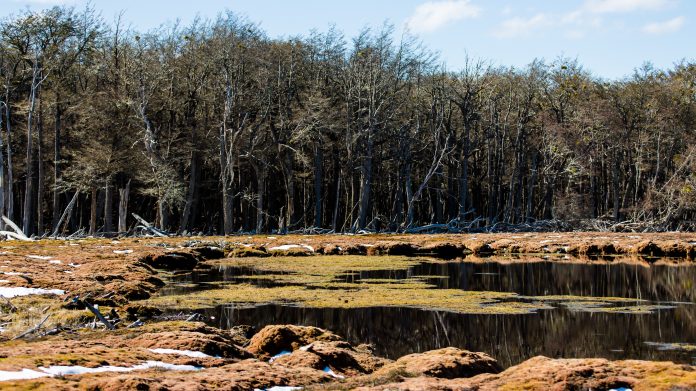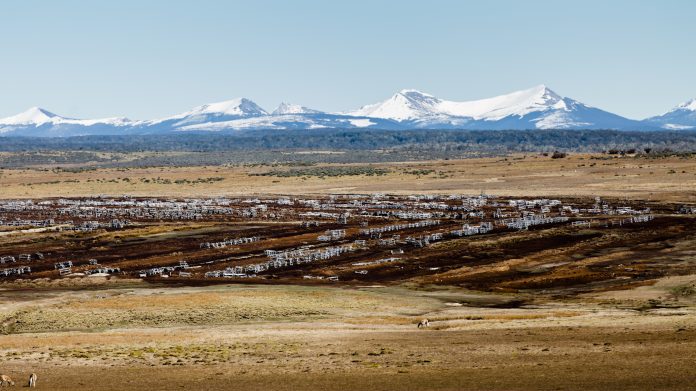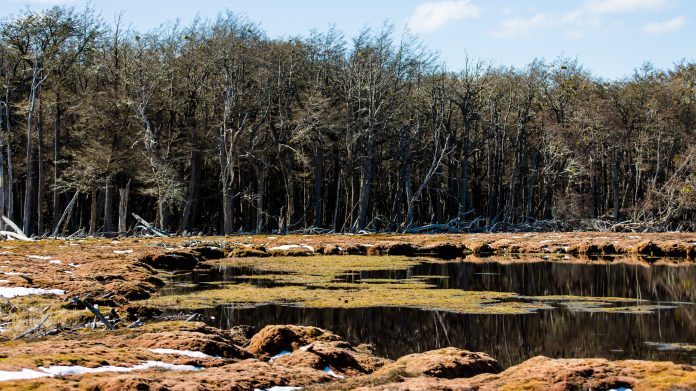By Jorge Hoyos-Santillán, postdoctoral researcher at the Center for Climate and Resilience Research (CR)2
Peatlands, as we can appreciate in image 1, are a type of wetland that serve a dual function, releasing and capturing carbon simultaneously to and from the atmosphere (Joosten & Clarke 2002). The mechanism they use to sequester carbon is the accumulation of partially decomposed organic matter (leaves, branches, fruit, roots) with a carbon-based molecular structure (lignin, carbohydrates, fatty acids). In peatlands, organic matter accumulates because more organic matter is produced than decomposes over the long run. For this to occur, specific environmental conditions are required that promote this accumulation of organic matter. For example, the soil needs to remain flooded or saturated with water for prolonged periods and the organic matter that is deposited needs to be somewhat resistant to degradation (Couwenberg & Joosten 1999).
Worldwide, peatlands cover close to 399 million hectares (Page et al., 2011) and contain approximately 644 giga-tons [1] of carbon accumulated during the Holocene period (Leifeld & Menichetti 2018), making them the most important carbon reservoirs in the biosphere (Yu, 2011), and one of the most important [2] carbon sinks on the planet. Because peatlands hold a carbon reservoir 1.7 times larger than the aerial biomass of all the world’s forests combined (Leifeld and Menichetti, 2018; Pan et al., 2011), and they have a major capacity for carbon sequestration, these ecosystems participate in regulating CO2 concentrations in the atmosphere (Frolking et al., 2011; Yu, 2011). At the same time, however, peatlands release major quantities of methane (CH4), influencing atmospheric concentrations of this greenhouse gas. Together, their capacity to sequester carbon and to release CH4 makes peatlands a major agent in climate regulation (Gorham et al., 2012; Tian et al., 2016; Yu et al., 2003) that has mitigated global temperature increases for thousands of years (Frolking et al., 2006).
 Image 1: Pristine peat bog in Tierra el Fuego, Chile.
Image 1: Pristine peat bog in Tierra el Fuego, Chile.
Today, the majority of peatlands that have not been altered by human activities continue to serve as carbon sinks, sequestering close to 0.1 giga-tons of carbon annually. Nevertheless, the current capacity of peatlands to sequester carbon is directly threatened by climate change (drought) and human activities (land use changes), and indirectly by forest fires and melting permafrost. It is believed that the degradation of peatlands around the globe could destabilize their carbon reservoirs, diminishing their potential capacity as carbon sinks to the point where they become net carbon emitters (Frolking et al., 2011).
In Chile, peatlands cover 2.3 to 3.1 million hectares (CONAF & CONAMA, 2006; Ruiz & Doberti, 2005). More than 90% of them are in Patagonia. With an average depth of 5.3 ± 0.3 metres, the peatlands of Patagonia have served as carbon sinks for the past 18,000 years, storing close to 4.8 giga-tons of carbon (Hoyos-Santillan et al., 2019). In Chile, however, peatlands are a resource subject to public concession, which has transformed some of them in the regions of Magallanes, Chilean Antarctic, Aysén, and Los Lagos into net sources of carbon emissions into the atmosphere (image 2).
 Image 2: Peatland in Tierra de Fuego degraded by the extraction of Sphagnum magellanicum.
Image 2: Peatland in Tierra de Fuego degraded by the extraction of Sphagnum magellanicum.
In 2019, the Intergovernmental Panel on Climate Change (IPCC) affirmed that the conservation and restoration of peatlands represents an alternative that could have an immediate impact on mitigating carbon emissions to the atmosphere (IPCC, 2019). Along the same line, for several years now peatlands have been identified as part of natural or nature-based climate solutions. These mechanisms seek to use conservation, restoration, and appropriate land management to increase carbon storage capacity and reduce greenhouse gas emissions in different ecosystems (forests, peatlands, grasslands) (Griscom et al., 2017). As a result, natural climate solutions could significantly help Chile to achieve the greenhouse gas mitigation targets proposed by the country in the updated Nationally Determined Contributions, facilitating the country’s advancement toward carbon neutrality by 2050 (Hoyos-Santillan et al., 2019). Unfortunately, there are several obstacles that impede the adequate implementation of natural climate solutions in Chile. In the specific case of Patagonian peatlands, one of the main obstacles is the high degree of uncertainty in estimating the area and carbon content of these ecosystems. Similarly, there is scant information available to quantify the rate of peat accumulation or rates of carbon emissions in these Patagonian peatlands. Even less available is information related to the impact of climate change and its interaction with human activities on the net carbon balance in peatlands. Despite this, preliminary estimates suggest that the peatlands of Chilean Patagonia could sequester around 13 million tons of carbon between 2020 and 2050. This might not seem a great deal owing to the low rates of carbon accumulation in Patagonian peatlands. However, the fact that peatlands function as sinks and not as carbon emission sources guarantees the conservation of the major carbon reservoir they represent, which is 4.7 times greater than the aerial biomass of all the forests of Chile (Hoyos-Santillan et al., 2019).
Finally, in addition to playing a central role in our country’s carbon inventory, it is important to recall that these ecosystems are a structural component of different hydrographic basins, contain exceptional biodiversity, and are a repository of high-resolution paleoecological records. Therefore, the conservation of peatlands not only represents an additional mechanism for achieving carbon neutrality; it could also represent a fundamental pillar for conserving Chile’s biodiversity in the context of global climate change.
Notes
[1] A gigaton is equal to one billion tons (Gt C; 1 × 109 tons of carbon).
[2] Sink: All processes, activities, or mechanisms that extract from the atmosphere a greenhouse gas, aerosol, or a precursor of either. Reservoir: A component of the climate system excluding the atmosphere with the capacity for storing, accumulating, or releasing a substance under study (for example, carbon, greenhouse gases, or their precursors). Oceans, soils, and forests are examples of carbon reservoirs. An equivalent term is deposit (note, however, that the term deposit also often includes the atmosphere). The absolute quantity of a given substance in a reservoir during a given time is called the reserve.
References
CONAF, CONAMA, 2006. Monitoreo y actualización: Catastro de uso del suelo y vegetación, Región de Magallanes y Antártica Chilena. Santiago, Chile.
Couwenberg, J., Joosten, H., 1999. Pools as Missing Links: The Role of Nothing in the Being of Mires, in: Standen, V., Tallis, J., Meade, R. (Eds.), Patterned Mires and Mire Pools- Origin and Development; Flora and Fauna. British Ecological Society, Durham, pp. 87–102.
Frolking, S., Roulet, N., Fuglestvedt, J., 2006. How northern peatlands influence the Earth’s radiative budget: Sustained methane emission versus sustained carbon sequestration. J. Geophys. Res. 111, G01008. https://doi.org/10.1029/2005JG000091
Frolking, S., Talbot, J., Jones, M.C., Treat, C.C., Kauffman, J.B., Tuittila, E.-S., Roulet, N., 2011. Peatlands in the Earth’s 21st century climate system. Environ. Rev. 19, 371–396. https://doi.org/10.1139/a11-014
Gorham, E., Lehman, C., Dyke, A., Clymo, D., Janssens, J., 2012. Long-term carbon sequestration in North American peatlands. Quat. Sci. Rev. 58, 77–82. https://doi.org/10.1016/j.quascirev.2012.09.018
Griscom, B.W., Adams, J., Ellis, P.W., Houghton, R.A., Lomax, G., Miteva, D.A., Schlesinger, W.H., Shoch, D., Siikamäki, J. V., Smith, P., Woodbury, P., Zganjar, C., Blackman, A., Campari, J., Conant, R.T., Delgado, C., Elias, P., Gopalakrishna, T., Hamsik, M.R., Herrero, M., Kiesecker, J., Landis, E., Laestadius, L., Leavitt, S.M., Minnemeyer, S., Polasky, S., Potapov, P., Putz, F.E., Sanderman, J., Silvius, M., Wollenberg, E., Fargione, J., 2017. Natural climate solutions. Proc. Natl. Acad. Sci. 114, 11645–11650. https://doi.org/10.1073/pnas.1710465114
Hoyos-Santillan, J., Miranda, A., Lara, A., Rojas, M., Sepulveda-Jauregui, A., 2019. Protecting Patagonian peatlands in Chile. Science (80-. ). 366, 1207–1208. https://doi.org/10.1126/science.aaz9244
IPCC, 2019. Climate Change and Land.
IPCC, 2013: Glosario [Planton, S. (ed.)]. In: Cambio Climático 2013. Bases físicas. Contribución del Grupo de trabajo I al Quinto Informe de Evaluación del Grupo Intergubernamental de Expertos sobre el Cambio Climático [Stocker, T.F., D. Qin, G.-K. Plattner, M. Tignor, S.K. Allen, J. Boschung, A. Nauels, Y. Xia, V. Bex and P.M. Midgley (eds.)]. Cambridge University Press, Cambridge, United Kingdom and New York, NY, USA
Couwenberg, J., Joosten, H., 2002. Wise Use of Mires and Peatlands: Background and Principles including a Framework for Decision-Making. International Mire Conservation Group and International Peat Society, Saarijärvi, Finland.
Leifeld, J., Menichetti, L., 2018. The underappreciated potential of peatlands in global climate change mitigation strategies. Nat. Commun. 9, 1071. https://doi.org/10.1038/s41467-018-03406-6
Page, S.E., Rieley, J.O., Banks, C.J., 2011. Global and regional importance of the tropical peatland carbon pool. Glob. Chang. Biol. 17, 798–818. https://doi.org/10.1111/j.1365-2486.2010.02279.x
Pan, Y., Birdsey, R.A., Fang, J., Houghton, R., Kauppi, P.E., Kurz, W.A., Phillips, O.L., Shvidenko, A., Lewis, S.L., Canadell, J.G., Ciais, P., Jackson, R.B., Pacala, S.W., McGuire, A.D., Piao, S., Rautiainen, A., Sitch, S., Hayes, D., 2011. A Large and Persistent Carbon Sink in the World’s Forests. Science (80-. ). 333, 988–993. https://doi.org/10.1126/science.1201609
Ruiz, J., Doberti, M., 2005. Catastro y caracterización de los turbales de Magallanes. Punta Arenas, Chile.
Tian, H., Lu, C., Ciais, P., Michalak, A.M., Canadell, J.G., Saikawa, E., Huntzinger, D.N., Gurney, K.R., Sitch, S., Zhang, B., Yang, J., Bousquet, P., Bruhwiler, L., Chen, G., Dlugokencky, E., Friedlingstein, P., Melillo, J., Pan, S., Poulter, B., Prinn, R., Saunois, M., Schwalm, C.R., Wofsy, S.C., 2016. The terrestrial biosphere as a net source of greenhouse gases to the atmosphere. Nature 531, 225–228. https://doi.org/10.1038/nature16946
Yu, Z., 2011. Holocene carbon flux histories of the world’s peatlands: Global carbon-cycle implications. The Holocene 21, 761–774. https://doi.org/10.1177/0959683610386982
Yu, Z., Campbell, I.D., Campbell, C., Vitt, D.H., Bond, G.C., Apps, M.J., 2003. Carbon sequestration in western Canadian peat highly sensitive to Holocene wet-dry climate cycles at millennial timescales. The Holocene 13, 801–808. https://doi.org/10.1191/0959683603hl667ft




